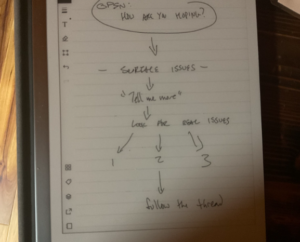Getting Home

Or, How to Find The Real Issues
If you’re a regular reader, you know I love the game of football. I coached it, I played it, and I still follow my Vols even after a decade of incompetent leadership.
And sometimes, it provides a helpful metaphor for sales.
Today, we’re talking about “getting home.”
But first, we pause to remember the great Derrick Thomas.

Man, he was good.
“Getting home” is a term for sacking the other team’s quarterback when you’re on defense.
And today, we’re stealing it to explain how you can more easily and readily cut to the real issues your prospects MAY have. But not just any issues. The ones that cause them to buy.
Too many people don’t know where to look: they either wander aimlessly on calls, or they assume the issues are there and go in too hard and too fast. Both leave the salesperson lunging for a reason to do business.
We’re going to adjust your approach so that when you meet with a prospect, you can “get home.” This is what I do with my clients in our training and coaching programs.

Does this guarantee every conversation turns into a sale? No. But we guarantee if you do this, and work at doing it well, a LOT more will.
I’ve listened to, run, or been on the receiving end of 1000s of sales calls over the years.
Here’s the skinny: most sellers don’t uncover the reason someone wants to buy. They think they have it (and use that word when describing the opportunity), or assume the stated issue is it. Sadly, they’re trading in hope. And giving me something to write about.
And like a postmodernist’s take on the tree in the woods, if no one says it, it doesn’t exist. At least for the person selling.
The result? Professionals and salespeople run around chasing opportunities when they have 0 understanding of what really matters to a potential buyer/client/customer. Let’s fix that.
Most sales calls start with some script about the founding of the company.
Or lately, to make the kids feel good, a lot of talk about vision and values and mission.
Stop.
Start with one question.

It doesn’t have to be mine: “How are you hoping I can help?”
But it needs to be in that ballpark.
Why? Asking someone why they are with your cuts to the quick and removes room for assumptions.
Don’t like my question? Try one of these:
- Why’d you take this meeting?
- You’ve got someone doing what we do – what are you hoping to get out of this conversation?
- What are you looking for?
It’s not rocket science. It’s also not scripted, so it requires you to listen.
Whatever the prospect says to this, short of, “I don’t know,” or, “I”m here because I was told I needed to be,” your response should be, “Tell me more about that.”
And that will open the conversation up if you’re patient enough to let it.
You’ll hear things that are topical, meaning on the surface what the person really wants or needs. So you’ll need to be alert, and ready to start digging.

A client told me the other day that he doesn’t ask good questions. He asked, “What should I be asking?”
I said, “Work off what they give you. If you’ll listen, you’ll know where to go. You just have to care about what they say.”
It’s true. Try me on it. If someone tells you about a budget being cut, ask how that decision was made. How it affects them. How people feel about it. Information will start to pour out, and if you’re listening, you’ll know where to take it.
If, and this is a HUGE “if”, you know the problems you solve for your customers or clients.
Most people don’t. They think they do. They provide some services for companies using Salesforce Marketing Cloud. Or they sell parts to medical supply companies. Or they sell machine-learning artificial intelligence to banks. Or they provide legal services.
Those are all the “How?”
It’s not what the other person is buying. It’s not the story in their head.
People calling attorneys are seeking freedom from fear, anxiety, and loss.
Companies buying software need to get time back, or increase sales, or figure out how not to look like the jackass who recommended the 6 figure Salesforce upgrade last year.
That’s the sort of thing people -and companies – buy.
My “How?” is training and coaching. But you know what people are buying?
- Attorneys are buying a doubling of cash flow.
- CEOs are buying a way to manage the pressure from the PE investors who bought them.
- Business owners are buying a competitive insight when they’re outgunned by larger players.
To get to that point, though, I have to know what issues to look for. Again, no services or products to talk about.
- Attorneys are upset because they’re not closing enough of the leads they’ve paid so much for.
- CEOs are frustrated because they are burning pipelines to make their number and aren’t sure how to build something repeatable.
- Owners know there’s something they can be doing differently with regard to technology and information and their team, but they aren’t sure what.
So I’m looking for the trail that leads me to those items. What I describe as the “real issues.”
Those are the numbered items in my image. I’m looking for one of those. And when I find it, I do something unexpected.
I ask them to “tell me more about that.” Because that’s what they need to talk about. And they need someone to hear.
“Put in the work, son.” Football coaches would say that to me in the off-season in high school. So it’s getting passed onto you.
This is the work. It’s thinking backward.

Most of us talk in terms of what we do, the thing we sell or make. Start there. Write it down.
Then go to step 2. How does this help the person you sell to? Get specific. In our old marketing class, this is called the “benefit.” Write down as many as you can.
Now move to step 3. What does their life look like before you show up to offer this wonderful benefit with what you do? For every benefit they receive, what problem do they have before you ride in on your horse to save the day? Put that on paper and make it clear. Specific. Use their language.
Why their language?
Because that’s how they think and talk.
That problem – they’re looking for a way out.
Sometimes it’s not that straightforward, though. There’s a fight to get to the issues.
And our first question falls flat.
Someone says, “I don’t know. You called me.” Or they say, “Ralph said you’re great. What do you do?”
Maybe they’re a hostage in the meeting, having been told to meet with you.
Maybe they don’t know what they’re looking for.
You gotta pivot a little. It’s ok. This is what makes selling a game.

Your second shot at getting this conversation to open up is to tell a couple of mini-stories or give 2-3 reasons people like them want to talk to you. Again, not the thing you sell.
“Professional service providers call me because they’re damn good at tax, or the law, or putting together real estate transactions. But they’re letting leads go through their hands, and it’s costing them 6 figures a month.”
“CEOs want to talk to me because they’ve grown a great business and revenue has gone from 5 million to 20 million, and they’ve sold. Now their investors want bigger growth all the time, and it’s harder than ever. The CEOs who come from finance or product or operations are unsure what to do to deliver that growth. The hotshot CRO they hired didn’t pan out, and the increased marketing spend hasn’t yet been delivered. They’re looking for a way to make sales manageable and predictable.”
Want a formula? It goes like this:
- I help (title you sell to)
- Who have done (some thing) well <— Gotta manage egos, folks
- But have (issue 1) that looks like (example)
- Or they don’t have (issue 1), but are dealing with (issue 2) that looks like (example)
That’s the sort of thing people respond to. If those issues resonate.
Pro tip: Know the world of your audience. The more you know it, the more finely you can craft these mini-stories, and the closer they’ll land to home.
You’re just looking for the prospect to say, “How do you help?” That, my friend, is a sign you’re closing in on an issue.

If you don’t get them leaning in and begging you to save the day, simply ask, “Is any of this relevant, or am I way in left field here?”
If they respond affirmatively, simply ask them to……
Tell you more.

And then you need to follow the thread back to the issues you solve.
Which means listening to what they’re saying.
It’s risky, you know. You may not know what to say or do. I’m betting you’ll figure it out though, if you’re curious.
More often than not, if you know what you’re looking for, you find a way to get there.
Even when your partner in the conversation seems to be wandering and you’re thinking about the clock.
Here’s a thought: if you don’t know where they’re going, stop them and say, “Bob, I’m confused, and I’m sorry. You’re talking about budget cuts, and I am not sure how I can help there. I’m a hardware provider, and we help with various software measures, but help me out – where are we going?”
Bob will tell you. He may have come upon something he wants your help with.
A client in one of our training programs told me last week that he was having great conversations with potential customers. They talked about all the issues in the industry.
When my client pivoted to ask the potential customers if they wanted to work with him, he’d forgotten to ask if those industry issues were a problem for the people he was talking to. He assumed, and it led to silence.
Most of the time – probably 80% – that I talk to someone trying to sell something – and it can be hardware, software, or services – the issue their deal isn’t moving or hasn’t closed has nothing to do with budgets or pricing, or timing. It’s almost always that there’s not been a compelling reason – a real reason – to buy discussed.
Compelling reasons get you home.
Assuming and guessing and presenting? They leave you diving at ankles.
You have a meeting in the next week or so with a potential client or customer.
Map out the meeting, from “How are you hoping I can help?” to, “Here are the 2-3 reasons people want to work with us.”
Write it out. Do the exercise above. If you need help, call on a customer and ask them, “Why’d you buy?” I guarantee it’s a reason you didn’t recognize when they did buy from you.
Then tell me how it goes.
Is this all there is? No, but it’s the start many of you need.
Later we can talk about commitment and impact and when they need it solved. For now, just focus on getting home.


